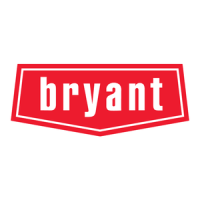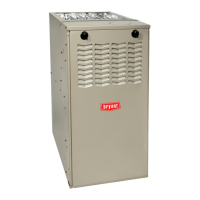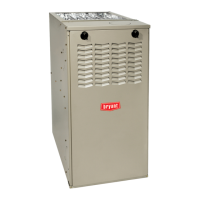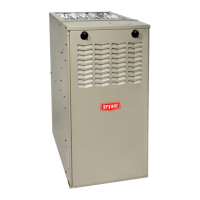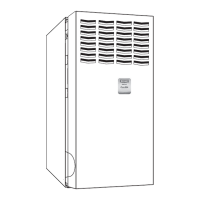l
Installation, Start–Up, Operating and
Service and Maintenance Instructions
NOTE: Read the entire instruction manual before starting the
installation.
TABLE OF CONTENTS
Table 1 – Dimensions . . . . . . . . . . . . . . . . . . . . . . . . . . . . . . . . . . . . . 2
SAFETY CONSIDERATIONS . . . . . . . . . . . . . . . . . . . . . . . . . . . . . . . 2
INTRODUCTION . . . . . . . . . . . . . . . . . . . . . . . . . . . . . . . . . . . . . . . . . 3
CODES AND STANDARDS. . . . . . . . . . . . . . . . . . . . . . . . . . . . . . . . . 4
ELECTROSTATIC DISCHARGE (ESD) PRECAUTIONS PROCE-
DURE . . . . . . . . . . . . . . . . . . . . . . . . . . . . . . . . . . . . . . . . . . . . . . . . . . . 5
LOCATION . . . . . . . . . . . . . . . . . . . . . . . . . . . . . . . . . . . . . . . . . . . . . . 6
Table 2 – Minimum Free Area Required for Each Combustion Air
opening of Duct to Outdoors . . . . . . . . . . . . . . . . . . . . . . . . . . . . . . . 7
Table 3 – Minimum Space Volumes for 100% Combustion, Ventila-
tion, and Dilution from Indoors . . . . . . . . . . . . . . . . . . . . . . . . . . . . . 8
INSTALLATION . . . . . . . . . . . . . . . . . . . . . . . . . . . . . . . . . . . . . . . . . . 9
Table 4 – Opening Dimensions - In. (mm). . . . . . . . . . . . . . . . . . . . 10
FILTER ARRANGEMENT . . . . . . . . . . . . . . . . . . . . . . . . . . . . . . . . . 12
Table 5 – Optional Filter Media Pressure Drop (Clean) Versus Airflow
- in. w.c. (Pa). . . . . . . . . . . . . . . . . . . . . . . . . . . . . . . . . . . . . . . . . . . 13
Table 6 – Optional Filter Media Pressure Drop (Clean) Versus Face
Velocity- in. w.c. (Pa). . . . . . . . . . . . . . . . . . . . . . . . . . . . . . . . . . . . 13
Table 7 – Air Filter Selection and Duct Sizing - In. (mm) . . . . . . . . 14
AIR DUCTS . . . . . . . . . . . . . . . . . . . . . . . . . . . . . . . . . . . . . . . . . . . . . 14
GAS PIPING. . . . . . . . . . . . . . . . . . . . . . . . . . . . . . . . . . . . . . . . . . . . . 15
Table 8 – Maximum Capacity of Pipe . . . . . . . . . . . . . . . . . . . . . . . 16
ELECTRICAL CONNECTIONS. . . . . . . . . . . . . . . . . . . . . . . . . . . . . 17
Table 9 – Electrical Data . . . . . . . . . . . . . . . . . . . . . . . . . . . . . . . . . 18
TEMPERATURE SENSOR . . . . . . . . . . . . . . . . . . . . . . . . . . . . . . . . . 19
VENTING. . . . . . . . . . . . . . . . . . . . . . . . . . . . . . . . . . . . . . . . . . . . . . . 21
Table 10 – Combined Appliance Maximum Input Rating
in Thousands of BTUh per Hour . . . . . . . . . . . . . . . . . . . . . . . . . . . 22
Table 11 – Minimum Allowable Input Rating of
Space-Heating Appliance in Thousands of BTUh per Hour . . . . . . 22
Table 12 – Recommended Minimum Vent Height Per Furnace and
Vent Orientation . . . . . . . . . . . . . . . . . . . . . . . . . . . . . . . . . . . . . . . . 24
Table 13 – Air Delivery - CFM (with Filter)* . . . . . . . . . . . . . . . . . 26
FURNACE CONTROL PROGRAMMING
AND NAVIGATION . . . . . . . . . . . . . . . . . . . . . . . . . . . . . . . . . . . . . . 28
Table 14 – System Status Display Codes . . . . . . . . . . . . . . . . . . . . . 29
Table 15 – Main Menu Options . . . . . . . . . . . . . . . . . . . . . . . . . . . . 29
SERVICE LABEL . . . . . . . . . . . . . . . . . . . . . . . . . . . . . . . . . . . . . . . . 31
START-UP, ADJUSTMENT, AND SAFETY CHECK . . . . . . . . . . . 31
Table 16 – Test Sequence . . . . . . . . . . . . . . . . . . . . . . . . . . . . . . . . . 32
WIRING DIAGRAM . . . . . . . . . . . . . . . . . . . . . . . . . . . . . . . . . . . . . . 32
Table 17 – Altitude Derate Multiplier for U.S.A.. . . . . . . . . . . . . . . 33
Table 18 – Gas Rate (CU ft./hr.). . . . . . . . . . . . . . . . . . . . . . . . . . . . 34
Table 19 – Orifice Size and Manifold Pressure (in. w.c.) for Gas Input
Rate . . . . . . . . . . . . . . . . . . . . . . . . . . . . . . . . . . . . . . . . . . . . . . . . . . 34
Table 20 – Orifice Size and Manifold Pressure (in. w.c.) for Gas Input
Rate . . . . . . . . . . . . . . . . . . . . . . . . . . . . . . . . . . . . . . . . . . . . . . . . . . 36
SERVICE AND MAINTENANCE PROCEDURES. . . . . . . . . . . . . . 39
ELECTRICAL CONTROLS AND WIRING . . . . . . . . . . . . . . . . . . . 39
CARE AND MAINTENANCE . . . . . . . . . . . . . . . . . . . . . . . . . . . . . . 40
Table 21 – Filter Size Information - In. (mm) . . . . . . . . . . . . . . . . . 40
SEQUENCE OF OPERATION . . . . . . . . . . . . . . . . . . . . . . . . . . . . . . 43
TROUBLESHOOTING . . . . . . . . . . . . . . . . . . . . . . . . . . . . . . . . . . . . 47
PARTS REPLACEMENT INFORMATION GUIDE . . . . . . . . . . . . . 50
EXAMPLE OF MODEL NUMBER . . . . . . . . . . . . . . . . . . . . . . . . . 50
TRAINING. . . . . . . . . . . . . . . . . . . . . . . . . . . . . . . . . . . . . . . . . . . . . . 50
To learn more about this appliance and installation via a mobile device,
go to https://bryant.hvacpartners.com/NFC or use the QR code below. To
access airflow tables or troubleshooting guide on your mobile device go
to mlctraining.com/training/techdocs/96/ or use the QR code below.
A230298
Most states in the USA and jurisdictions in Canada have laws that
require the use of Carbon Monoxide (CO) alarms with fuel burning
products. Examples of fuel burning products are furnaces, boilers, space
heaters, generators, water heaters, stoves/ranges, clothes dryers,
fireplaces, incinerators, automobiles, and other internal combustion
engines. Even if there are no laws in your jurisdiction requiring a CO
Alarm, it’s highly recommended that whenever any fuel burning product
is used in or around the home or business that the dwelling be equipped
with a CO Alarm(s). The Consumer Product Safety Commission
recommends the use of CO Alarm(s). The CO Alarm(s) must be
installed, operated, and maintained according to the CO Alarm
manufacturer’s instructions. For more information about Carbon
Monoxide, local laws, or to purchase a CO Alarm online, please visit the
following website. https://www.kidde.com.
A200103
Portions of the text and tables are reprinted from NFPA 54/ANSI Z223.1E, with permission of National Fire Protection Association, Quincy, MA 02269 and American
Gas Association, Washington DC 20001. This reprinted material is not the complete and official position of the NFPA or ANSI on the referenced subject, which is
represented only by the standard in its entirety.
880TB/881TB
80% AFUE, Two-Stage, Variable–Speed
4–Way Multipoise, Non-Condensing Gas Furnace
WARNING
!
CARBON MONOXIDE POISONING HAZARD
Failure to follow this warning could result in personal injury and/or
death.
Carbon Monoxide (CO) is a colorless, odorless, and tasteless poisonous
gas that can be fatal when inhaled. Follow all installation, maintenance,
and service instructions. See additional information below regarding
the installation of a CO Alarm.
Use of the AHRI Certified TM Mark indicates
a manufacturer’s participationin the program.
For verification of certification for individual
products, go to www.ahridirectory.org .
